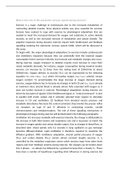Essay
Oxford Essay, Biomedical Sciences (Integrative Systems Physiology)
- Institution
- University Of Oxford
First-class second year undergraduate essay written for the Integrative Systems Physiology module of the Biomedical Sciences course at the University of Oxford. //Essay title: What is the role of the autonomic nervous system during exercise?// Very helpful for tutorial preparation and exam r...
[Show more]



